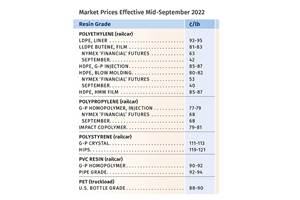Asahi Kasei Aims for ‘First-to-Market’ of a More Sustainable Nylon 66
In addition, Asahi Kasei Plastics North America (APNA) is on a roll with its expanded Leona portfolio of specialty nylon 66-based compounds.
Vertically integrated with parent company, compounder of specialty, high-performance, engineered polymers such a nylon 66-based, PPE, and chemically-coupled PP, Asahi Kasei Plastics North America (APNA) is developing and launching new engineered compounds for automotive applications, particularly for the electrification of automobiles.
Moreover, parent company Asahi Kasei Corporation is developing more sustainable versions of its innovative compounds through industry partnerships. As we have previously reported, it has teamed up with biotechnology firm Genomatica to commercialize renewably-sourced nylon 66. The partnership entails the use of Genomatica’s biobased HMD (hexamethylenediamine, also abbreviated as HMDA) building block. Genomatica has been able to change the DNA on certain bacteria so that they produce HMD after ‘eating’ sugars that do not disrupt the food chain in any way. Currently, HMD accounts for roughly half of the makeup of Leona nylon compounds, making this a significant step towards sustainability.
Asahi Kasei sees this collaboration as key to supporting its goal to be first-to-market with a more sustainable nylon 66 for the automotive and electronics industries, utilizing bio-HMD, and to accelerate the achievement of its corporate sustainability objectives. Asahi Kasei Corporation has preferential access to early volumes of renewably-sourced HMD and nylon application testing, leveraging the company’s expertise in developing successful nylon applications for use in products such as high-temperature automotive parts, electronics, or yarns to produce airbags. Asahi Kasei will have the opportunity to license Genomatica’s Geno HMD process technology to commercialize biobased nylon 66 once the technology is completed. While timetables are not currently being disclosed, Asahi Kasei is confident that its nylon-66 made with bio-HMD will have all the same quality and performance as it does now.

Meanwhile, I recently had the pleasure to interview industry veteran Todd Glogovsky, president and COO of APNA. Glogovsky has over 25 years of experience in the plastics industry supporting technology, sales and marketing. Prior to his current role, Glogovsky was a managing director at LyondellBasell, and he also worked at Bayer. We discussed some of the latest key technology offerings launched and under development.
Included is last year’s launch of a series of halogen-free and red-phosphorus-free flame-retardant nylon 66 resins targeted to E&E applications such as breakers, magnet switches, and compressed-air valves as well as automotive applications in powertrain parts and EV charging stations. The new Leona SN series is part of the company’s Leona nylon resin portfolio which also includes the standard Leona 14G series of anti-ultraviolet nylon 66 compounds, and the special semi-aromatic Leona 90G series (a combination of nylon 66 and 6I aromatic nylon) for use in replacing metals in automotive and industrial applications. Both these series are produced with high glass content. Glogovsky notes that Leona SG compounds with high-glass content (60%) continue to replace cast metals in high-pressure, high-strength areas and beyond automotive, such as window latches.
The new halogen-free SN series resins boast UL 94 V-0 and relative tracking index (CTI) of 600 V, good surface appearance, good laser transparency (Na) and laser printability (BK). Also claimed are enhanced productivity thanks to clearer and faster laser marking on gloss surfaces, and less mold deposit than conventional halogen-free and red-phosphorus-free materials. Moreover, although the properties of similar halogen-free nylon 66 materials are significantly reduced, Leona SN compounds can still maintain a high level of tensile strength and flexural modulus after moisture absorption.
Glogovsky sees all of APNA’s flame-retardant offerings as promising contenders for expanded use in electric vehicle battery applications, noting that the EV industry is very dynamic with a lot of learning taking place. “In such battery applications, ranging from highly structured components to lighter ones, you need all of these--nylon for its high temperature resistance, PPE for its strength and dimensional stability, and PP for its chemical resistance and lower pricing.”
Related Content
Volume Resin Prices Move in Different Directions
PE, PP, PVC, and ABS prices slump, while PS, PET, PC, and nylons 6 and 66 prices rise.
Read MorePrices for All Volume Resins Head Down at End of 2023
Flat-to-downward trajectory for at least this month.
Read MorePrices of Volume Resins Drop
Price relief is expected to continue through the fourth quarter for nine major commodity and engineering resins, driven by widespread supply/demand imbalances.
Read MorePBT and PET Polyester: The Difference Crystallinity Makes
To properly understand the differences in performance between PET and PBT we need to compare apples to apples—the semi-crystalline forms of each polymer.
Read MoreRead Next
Why (and What) You Need to Dry
Other than polyolefins, almost every other polymer exhibits some level of polarity and therefore can absorb a certain amount of moisture from the atmosphere. Here’s a look at some of these materials, and what needs to be done to dry them.
Read MoreTroubleshooting Screw and Barrel Wear in Extrusion
Extruder screws and barrels will wear over time. If you are seeing a reduction in specific rate and higher discharge temperatures, wear is the likely culprit.
Read More






.png;maxWidth=300;quality=90)

















